Poached Eggs
I eat between 3 and 5 eggs every single day, and have cooked thousands upon thousands of eggs for myself and my family. Here are my best tips for making Poached Eggs quickly and easily, in less than 10 minutes. No vinegar, no straining, no fuss!
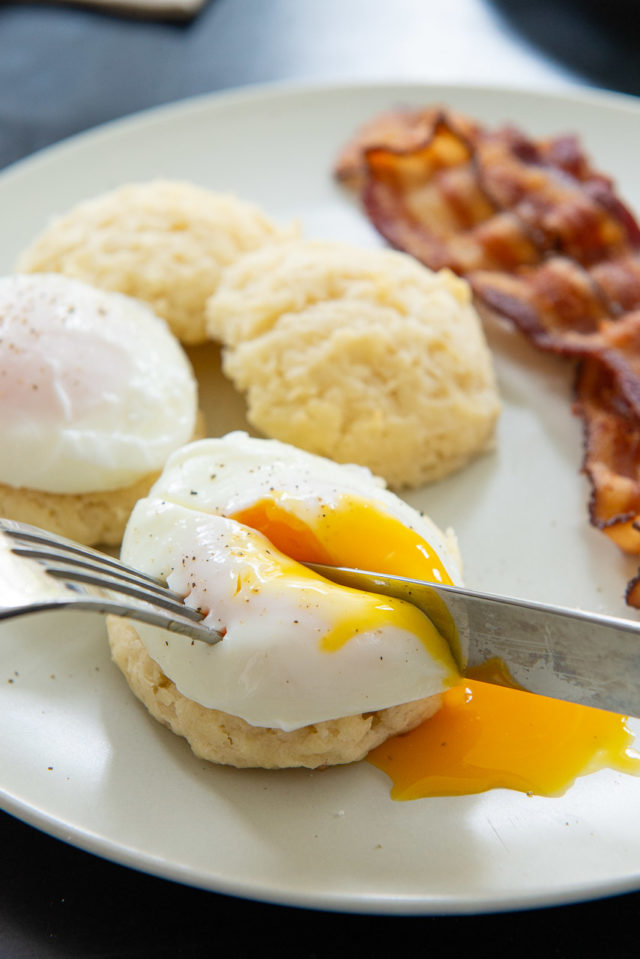
Seeing as my family goes through four dozen eggs per week, I’ve tested and repeated quite a few styles of preparation over the years, and poached eggs are one of my favorite variations.
There’s something so appealing about a poached egg, with its warm runny yolk encased in gently cooked white. A lot of people think of poached eggs as more restaurant cooking than every day cooking, but there’s no reason for that. Making them at home is simple!
I’ve seen a lot of different “hacks” that people share around the cooking process. I’ve tested many of these over the past 10 years since I first published this post, and honestly, a lot of these “hacks” in my experience don’t yield better results, and often times they’re worse. I haven’t found them to be worth the fuss.
Things You Shouldn’t Do
Here’s some of the general advice out there that I’ve tested and personally recommend you don’t do for poaching eggs.
Vinegar – In my experience, adding white vinegar to the water has always made the egg white coagulate strangely, no matter what amount I experiment with. Plus, you can taste it, even if it’s just a little vinegar. Don’t bother.
Strain the egg whites first – People say that swirling the cracked egg gently in a fine mesh sieve or strainer reduces whisps later on. I talk about this in depth below, but I prefer to deal with the egg white whisps in a different way that is way less fussy.
Salt the water – I get the thought process behind this, but salting the water results in a rougher overall texture. It’s better to season to taste afterward.
Swirl the water into a vortex – Swirling water in the pot is totally unnecessary for getting a beautifully rounded egg, and in my experience, this whirlpool method will make your egg look like a raggedy shooting star.
There’s also no need to buy a unitasking egg poacher in order to get the perfect poached egg. I’ll show you a foolproof way to do it well with the pans you already have in your kitchen. Home cooks can easily master this simple method with a little practice.
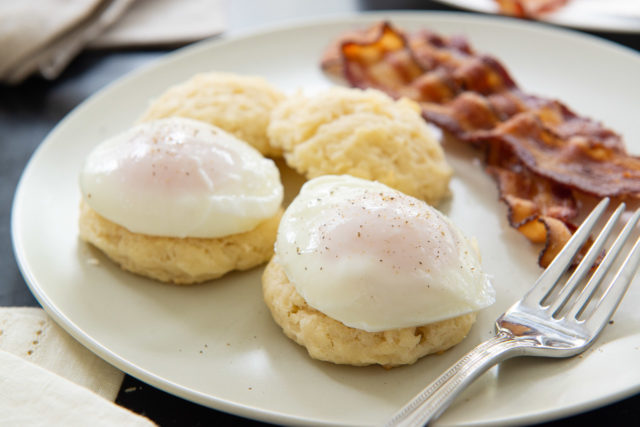
Tips for Best Results
Now here’s what you should do to make the best poached eggs.
Use your freshest eggs – The newer the better. Fresh eggs are tighter and hold together better, with firm whites and yolks. The egg yolk in older eggs is always more likely to break.
Use a skillet instead of a saucepan – This gives you more space to gently drop the egg in, and the egg won’t plunk down as far.
Use plenty of water – Have you ever noticed that when you stick pasta in boiling water, it stops boiling for a minute, and then needs another minute to come back up to a boil? It’s the same concept here. A cold egg will cool the hot water too much if there isn’t enough of it. Fill the pot a couple inches high.
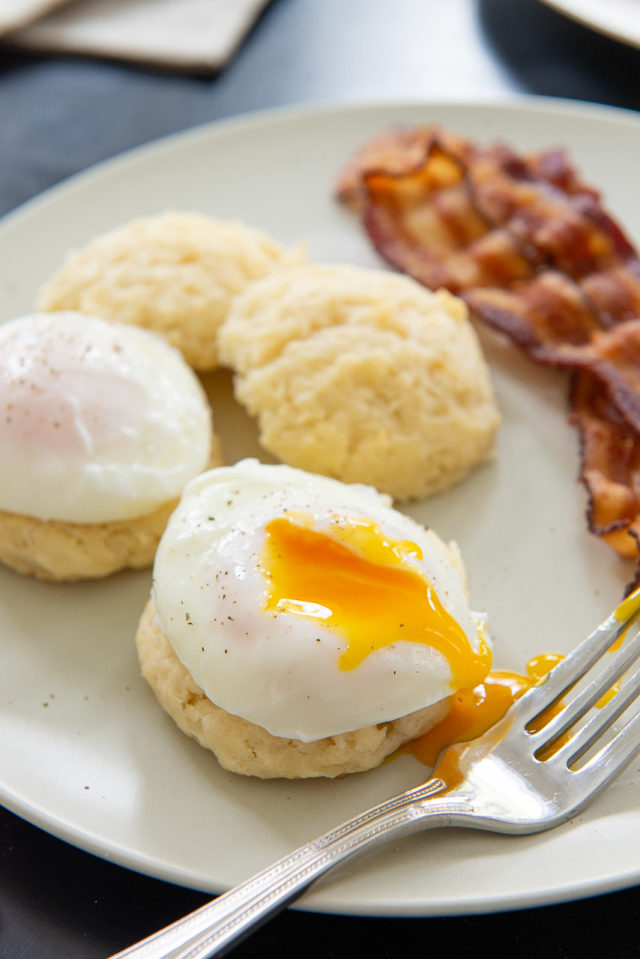
Step by Step Overview:
Here is a visual step-by-step guide of the process so you can understand what’s happening. Then I recommend following the recipe box below that when it’s time to make your poached eggs.
Crack the Eggs Into Bowls, Not Directly Into the Water
I know it’s slightly annoying to dirty a couple bowls, but this is essential. Cracking the eggs into a small bowl first allows you to gently slip them into the water, giving them that rounded shape you want.
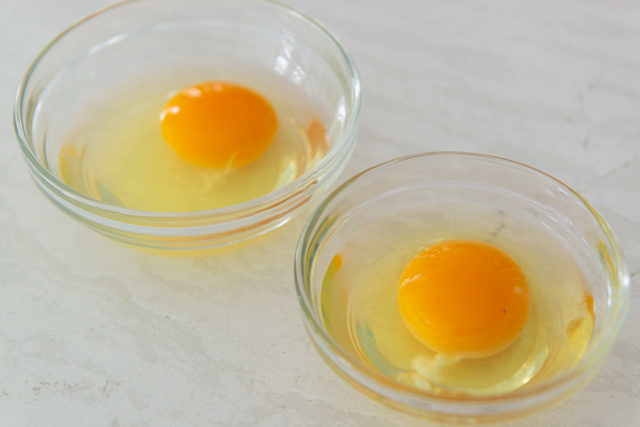
If you crack directly into the water, you can’t get as close (without risking burning your fingers), and the egg will plunk down in the water a bit more and have a weird shape.
Also, cracking them into a bowl first ensures that the yolk is still intact. No point in poaching an egg if the yolk has already broken.
Note: I am using cold eggs straight from the fridge. There is no need to bring the eggs to room temperature first.
Bring the Water to the Perfect Temperature with Zero Movement
You actually don’t want boiling water for poached eggs, because the bubbles will move the eggs around too much. I don’t even cook it at a gentle simmer either.
I get the water to the perfect temperature by first bringing it to a boil:
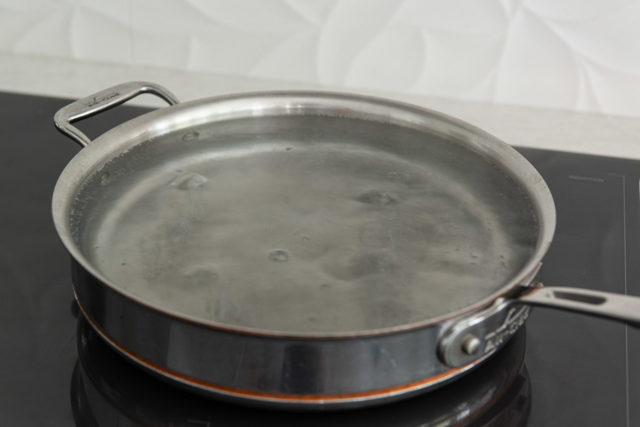
Then I dial the temperature back and find the point where it’s just under a simmer:
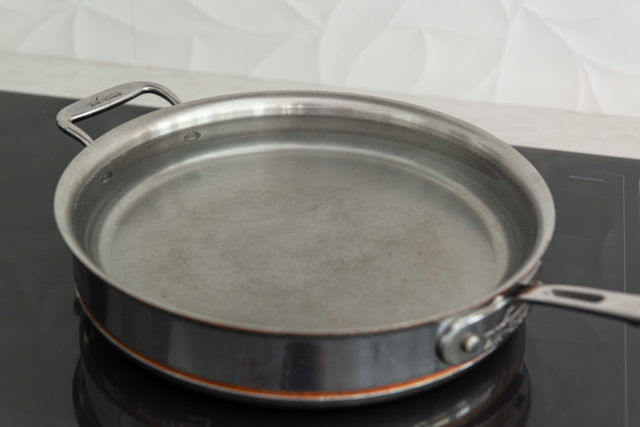
You can see there are no bubbles, but it’s still very hot. Even gently simmering water can sometimes have too much movement, and cooking at barely under a simmer still has sufficient heat for cooking.
Use a Shallow Skillet
It’s actually better to use a shallow and wide high-sided skillet instead of a pot. This gives you more space to gently drop the egg in, and the egg won’t plunk down too far. You only need a couple inches of water.
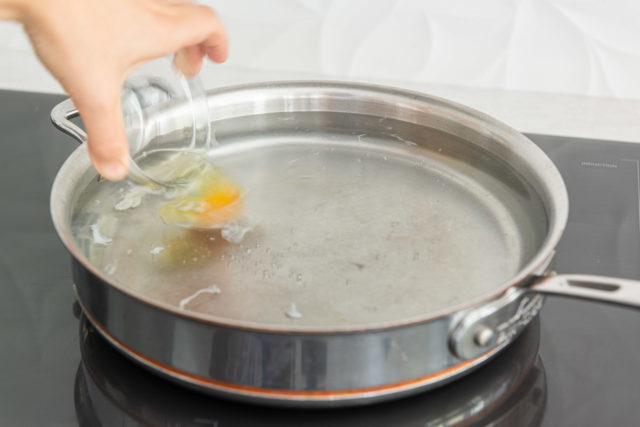
How Long to Poach an Egg
Cook the egg for 3 minutes, completely undisturbed. At this cooking time, the egg white should be completely set, but the yolk will still be runny.
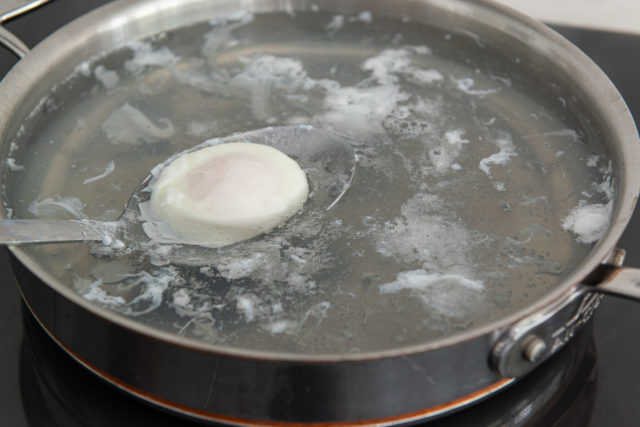
Remove the poached egg with a slotted spoon (affiliate) and transfer to a paper towel-lined plate to absorb the excess water.
Trim the Whispy Egg White Threads
There will be whispy egg white threads, but they only take a few seconds to remove. If you look, you can see there are some thin parts below:
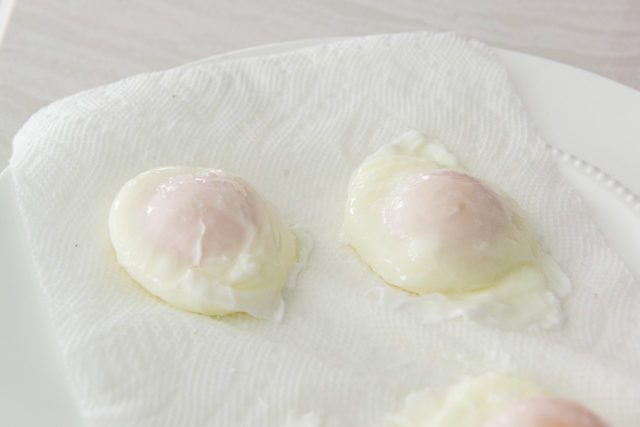
All you have to do is run a butter knife around the edges and trim these watery whites off:
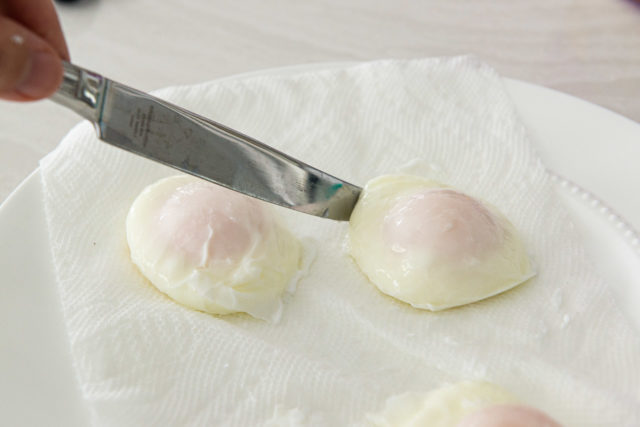
Why Quick Trimming Is Better than Straining Beforehand
Some people recommend that you swirl the loose egg white in a fine mesh strainer before cooking, in order to minimize whispy threads. I tried this and found it to be too much bother and fuss for something that can be easily trimmed up after cooking.
And, if you prefer pastured eggs like I do, they tend to have extra delicate yolks. You have to shift each egg around in the strainer pretty vigorously to remove the loose whites, and it can risk breakage.
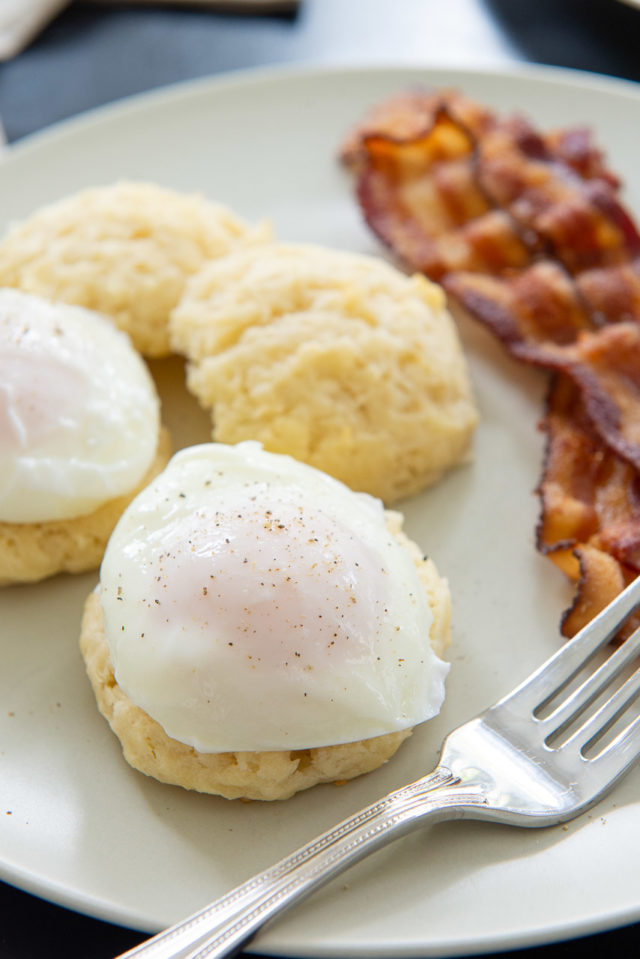
Once you’ve trimmed away any wispy whites around the side, serve right away, adding a little salt and pepper on top as desired. There is no need to plunk your perfectly poached egg into an ice bath or cold water.
How to Serve
After you’ve taken a quick few seconds to drain the egg on the paper towel and trim any egg white whisps as desired, serve the poached eggs immediately. You want to enjoy the runny egg yolks while they are warm.
Throw a couple eggs on top of this Sweet Potato Hash, or pair with Spanish Tortilla or Hash Browns. These are also perfect for eggs benedict (try it with a Homemade English Muffin), or for adding protein to avocado toast.
Also see my method for easy peel Hard Boiled Eggs and How to Make an Omelette. Enjoy!
Recipe Tips and FAQ
It’s best to only make as much as you plan to eat. However, you can keep leftovers in the fridge for up to 2 days.
Not recommended. The texture will be horrid upon thawing.
Did you enjoy the recipe? Please leave a 5-star rating in the recipe card below and/or a review in the comments section further down the page. Or, follow me on Facebook, Instagram or Pinterest!

Poached Eggs
Ingredients
- 2 large eggs (use the freshest/newest you have)
Instructions
- Fill a large 10 or 12" high-sided skillet with 2 inches of water, then bring to a boil over high heat. Reduce the heat to wherever the water is just below a simmer, which is likely medium high or medium. You don't want any movement or bubbles in the water.
- Carefully crack each egg into its own small bowl.
- Gently lower each egg into the hot water, getting the bowl as close to the water as possible to minimize dropping of the egg.
- Cook the eggs for 3 minutes, then remove to a paper towel-lined plate using a slotted spoon.
- Serve immediately. I love them atop Drop Biscuits with a side of bacon (See: How to Cook Bacon in the Oven). Enjoy!
Notes
Nutrition
Nutrition is estimated using a food database and is only intended to be used as a guideline for informational purposes.
Post updated in November 2020 with new photos and tips. Originally published January 2011.

24 Comments on “Poached Eggs”
I just tried this and my eggs turned out perfect! So easy, no fuss. No swirling, no straining, no vinegar, no salt. Until now, I rarely made poached eggs bc it was too complicated and then they didn’t turn out well. Cooking them in a skillet with high sides instead of a sauce pan adds to the ease. Thanks for the detailed instructions.
So happy to hear this!!
Works like a charm without being overly precious.
Hi Joanne
My wife and I enjoy poached eggs very much. I will make them at least once a week for us to enjoy. The one problem I run into is that they want to stick to the paper towel.
Ant suggestions on how to prevent this?
Thanks
Hi Frank, I am wondering if this varies by paper towel brand. What kind are you using? Try to use a high quality thick brand with a strong weave. Hopefully it’d be less likely to cling. Let me know if that helps.
Thank you Joanne! After buying various egg poaching tools & going the vinegar route I found your website & tried your method this morning. I just used a small high pan & simply popped the eggs in from a ramekin. 3 minutes – absolutely perfect.
Excellent!
First time trying poached eggs. Great recipe and easy with very satisfying results. Will be using this for cooking breakfast eggs from now on. Thank you !!
The poached eggs look perfect.
Can’t wait making them.
Hi there! I’m about to make your chicken parm recipe right now and while on that page, I saw the pic for this one and am dying to know: What do you have the eggs on top of in this pic? It looks like a biscuit or something, regardless it looks freaking HEAVENLY so if you don’t mind letting me know, I would SO appreciate it! Thanks so much!
They are my drop biscuits. Recipe here: https://www.fifteenspatulas.com/drop-biscuits/
Had fabulous success. Thankyou
Wonderful!!
I’ve always had problems with poached eggs. I’ve tried several methods and cannot seem to replicate consistent success. You do 2 eggs at a time and are not using boiling water or stirring them. I’ll give it a try. We always enjoy poached eggs with beef or pork hash or Eggs Benedict. I’ll update my post after trying.
I always ate poached eggs at my grandma’s house. The way she did it was to crack the egg into a skillet, then let it cook until the white is cooked slightly. Then, take the lid of the skillet, add a little bit of water on the other side of the skillet (opposite the egg), then quickly put the lid over the skillet. This allows the steam to cook the yolk slightly, without cooking it all the way through. This is the way I’ve always done it, so maybe it’s a weird thing my family does? Good to see the other methods, though!
Hi Emily, very cool! I have never heard of that method, sounds like the steam from the water cooks the egg. Grandma’s do know some pretty awesome tricks =)
to use the vortex method you ideally need a tall deep saucepan to allow 6″ of water depth,get egg ready in a small cup(easier to handle than a plate in confined spaces) use a long spoon to create a strong vortex and the add egg gently into the eye of the tornado,if it’s fresh(the egg)it should sink down slow enough for the albumin to swirl around the yolk and start to set in a teardrop shape,after 30 secs it can be removed and put in to iced water to stop the cooking process, repeat this step until you have enough eggs for your needs,then when you need them,assemble the dish and at last minute drop eggs back into a pan off boiling water for 2 mins to heat through and serve,amaze your many breakfast/dinner party guests with your amazing all cooked perfect and at the same time..
My family has been using a pseudo-poaching method for years for our Eggs on Toast breakfasts. With 6 kids in the family it was difficult to get all the eggs in and out in a timely way using traditional poaching methods. Here’s what we do:
Use a non-stick pan or spray pam-type oil onto pan; crack the eggs into the pan while it’s still cold – try to get them as evenly spaced as possible; gently pour water into the pan (in between a couple of eggs) until the water just covers the tops of the eggs; cover the pan & turn on the stove burner to med-high; it’s easiest with a glass lid, you can watch the water to see how it’s boiling. The water will boil & sticky bubbles will cover the eggs. When that happens the eggs are done. With an aluminum lid, it’s more a matter of figuring out how long your instruments take to get the job done.
The best part about using this method is that you can time your toast so it’s still warm & just buttered when the eggs get done.
Very cool! Thanks for sharing this tip with everyone!
I’ve never ever poached an egg before, so I think I shall try it for dinner with a lightly toasted piece of wheat bread. To tired today to make biscuits at the moment.
How’d it go? I love just having a simple egg with a few sides for dinner!
I work in a restaurant and poached eggs used to be on our breakfast menu. Poaching under pressure, that was fun. Eggs are temperamental buggers sometimes.
Beautiful blog! I can’t wait to make the cupcakes with Earl grey frosting!
The only extra thing I do for egg-poaching ( I’m a FANATIC) is to slip them briefly onto a piece of paper towel before putting them on the toast/biscuit (love it)/whatever so they aren’t so slippery. And, chopped chervil -subtle and brilliant!
Thank you Niki! The earl grey cupcakes are fabulous!